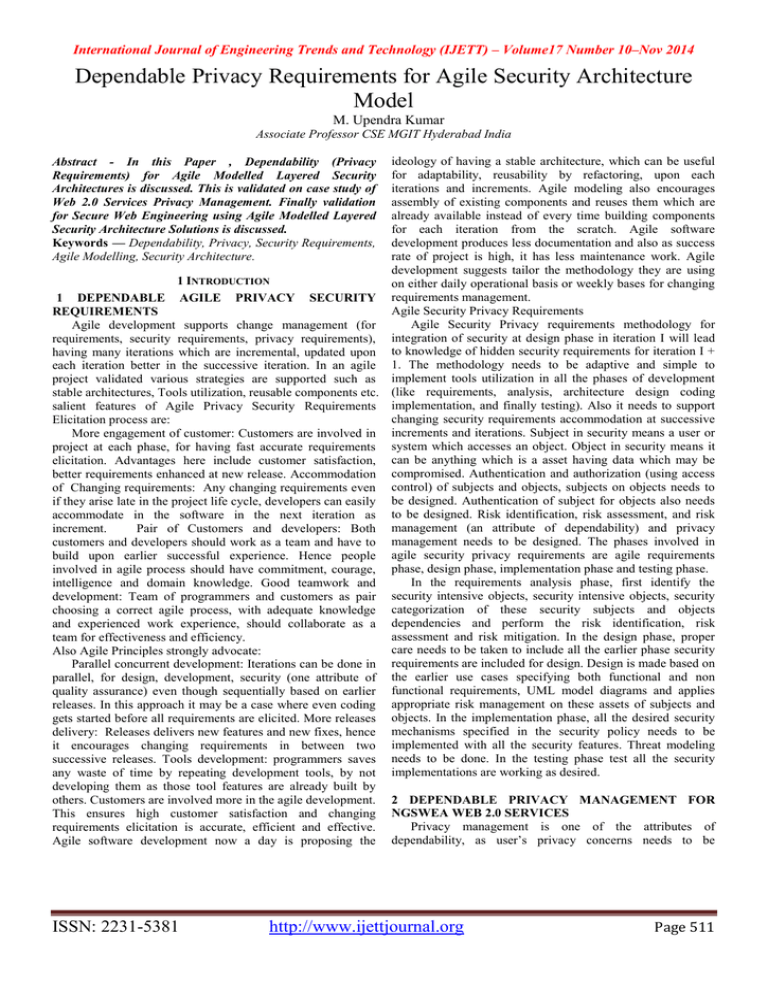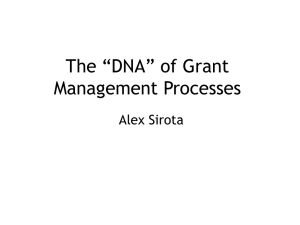Dependable Privacy Requirements for Agile Security Architecture Model
advertisement

International Journal of Engineering Trends and Technology (IJETT) – Volume17 Number 10–Nov 2014 Dependable Privacy Requirements for Agile Security Architecture Model M. Upendra Kumar Associate Professor CSE MGIT Hyderabad India ideology of having a stable architecture, which can be useful for adaptability, reusability by refactoring, upon each iterations and increments. Agile modeling also encourages assembly of existing components and reuses them which are already available instead of every time building components for each iteration from the scratch. Agile software development produces less documentation and also as success rate of project is high, it has less maintenance work. Agile development suggests tailor the methodology they are using 1 INTRODUCTION on either daily operational basis or weekly bases for changing 1 DEPENDABLE AGILE PRIVACY SECURITY requirements management. Agile Security Privacy Requirements REQUIREMENTS Agile Security Privacy requirements methodology for Agile development supports change management (for requirements, security requirements, privacy requirements), integration of security at design phase in iteration I will lead having many iterations which are incremental, updated upon to knowledge of hidden security requirements for iteration I + each iteration better in the successive iteration. In an agile 1. The methodology needs to be adaptive and simple to project validated various strategies are supported such as implement tools utilization in all the phases of development stable architectures, Tools utilization, reusable components etc. (like requirements, analysis, architecture design coding salient features of Agile Privacy Security Requirements implementation, and finally testing). Also it needs to support changing security requirements accommodation at successive Elicitation process are: More engagement of customer: Customers are involved in increments and iterations. Subject in security means a user or project at each phase, for having fast accurate requirements system which accesses an object. Object in security means it elicitation. Advantages here include customer satisfaction, can be anything which is a asset having data which may be better requirements enhanced at new release. Accommodation compromised. Authentication and authorization (using access of Changing requirements: Any changing requirements even control) of subjects and objects, subjects on objects needs to if they arise late in the project life cycle, developers can easily be designed. Authentication of subject for objects also needs accommodate in the software in the next iteration as to be designed. Risk identification, risk assessment, and risk increment. Pair of Customers and developers: Both management (an attribute of dependability) and privacy customers and developers should work as a team and have to management needs to be designed. The phases involved in build upon earlier successful experience. Hence people agile security privacy requirements are agile requirements involved in agile process should have commitment, courage, phase, design phase, implementation phase and testing phase. In the requirements analysis phase, first identify the intelligence and domain knowledge. Good teamwork and development: Team of programmers and customers as pair security intensive objects, security intensive objects, security choosing a correct agile process, with adequate knowledge categorization of these security subjects and objects and experienced work experience, should collaborate as a dependencies and perform the risk identification, risk assessment and risk mitigation. In the design phase, proper team for effectiveness and efficiency. care needs to be taken to include all the earlier phase security Also Agile Principles strongly advocate: Parallel concurrent development: Iterations can be done in requirements are included for design. Design is made based on parallel, for design, development, security (one attribute of the earlier use cases specifying both functional and non quality assurance) even though sequentially based on earlier functional requirements, UML model diagrams and applies releases. In this approach it may be a case where even coding appropriate risk management on these assets of subjects and gets started before all requirements are elicited. More releases objects. In the implementation phase, all the desired security delivery: Releases delivers new features and new fixes, hence mechanisms specified in the security policy needs to be it encourages changing requirements in between two implemented with all the security features. Threat modeling successive releases. Tools development: programmers saves needs to be done. In the testing phase test all the security any waste of time by repeating development tools, by not implementations are working as desired. developing them as those tool features are already built by others. Customers are involved more in the agile development. 2 DEPENDABLE PRIVACY MANAGEMENT FOR This ensures high customer satisfaction and changing NGSWEA WEB 2.0 SERVICES Privacy management is one of the attributes of requirements elicitation is accurate, efficient and effective. Agile software development now a day is proposing the dependability, as user‟s privacy concerns needs to be Abstract - In this Paper , Dependability (Privacy Requirements) for Agile Modelled Layered Security Architectures is discussed. This is validated on case study of Web 2.0 Services Privacy Management. Finally validation for Secure Web Engineering using Agile Modelled Layered Security Architecture Solutions is discussed. Keywords — Dependability, Privacy, Security Requirements, Agile Modelling, Security Architecture. ISSN: 2231-5381 http://www.ijettjournal.org Page 511 International Journal of Engineering Trends and Technology (IJETT) – Volume17 Number 10–Nov 2014 maintained by applications in terms of non disclosure of customer‟s private information to public. For Web 2.0 services privacy management, Patlet 5.1 provides adding of policy header and Patlet 5.2 provides Policy tailor for Privacy requirements. PATLET 1 ADD POLICY HEADER FOR PRIVACY REQUIREMENTS FOR WEB 2.0 SERVCIES <!DOCTYPE HTML PUBLIC "-//W3C//DTD HTML 4.0 Transitional//EN"> <html> <head> <meta http-equiv=‟P3P‟ content= „policyref=https://www.sites.google.com/site/upendracsemgi t.htm”, CP=”NOI DSP COR NID CURa OUR NOR NAV INT TST”‟ name=vs_targetSchema content="http://schemas.microsoft.com/intellisense/ie5"> <title>Privacy Demonstration</title> <script> Fig 1 Privacy Demonstration PATLET 2 POLICY TRAILOR FOR PRIVACY REQUIREMENTS FOR WEB 2.0 SERVCIES <h1 align="center">Privacy Demonstration</h1> <label id="Input"><span style="TEXT-DECORATION: underline"> U</span>ser Name:< /label> <input id="InputVal" type=text value="Dr.D.Sravan Kumar" name="InputVal" accesskey="U" title="Type your name." autocomplete=off/><p/> <input id="SaveCookie" type=button accesskey="S" value="Save Cookie" onclick="SetCookie()" name="SaveCookie" title="Click or press Alt+S to save the cookie."/> <input id="ReadCookie" type=button accesskey="R" value="Read Cookie" onclick="ReadCookie()" name="ReadCookie" title="Click or press Alt+R to read the cookie."/> </body> </html> Fig 2 Save Cookie option Figure 1 provides execution screen shot of Privacy Demonstration of web 2.0 services. Figure 2 provides execution screen shot of Save Cookie option and Figure 3 provides execution screen shot of Read Cookie option. Fig 3 Read Cookie option Figure 4 provides Class Diagram of the web 2.0 services privacy application. This application module will be extended in paper 6 for Secure Stock Market application. Here the classes are Customer, Manager, Broker and Auditor. Customer is associated with manager and auditor to perform various stock market operations. Broker is associated with auditor to perform auditing of shares information. ISSN: 2231-5381 http://www.ijettjournal.org Page 512 International Journal of Engineering Trends and Technology (IJETT) – Volume17 Number 10–Nov 2014 Figure 5 Development Process for Web based Systems Table 1 provides Program Logic for Secure Web Engineering Application. Table 1 PROGRAM LOGIC FOR SECURE WEB ENGINEERING APPLICATION Fig.4 Class diagram of the web 2.0 services privacy application 3 SECURE WEB ENGINEERING USING PROPOSED AGILE SECURITY MODEL The Proposed Agile security model for dependable privacy requirements can be extended to secure web engineering. Figure 5.5 provides the process of Web Engineering process design. The focus is on project management, documentation, quality control. The phases involved are Context Analysis ( The Domain of the usage of this Web Application, the Product Model how the product is publicized to the customers), The process model (used by the Web Application like Agile Modeling), Project Plan, Web site Development using Web Technologies and Web Site Maintenance Strategy. Input: Web Application URL Begin Input URL Extract list_of_pages using WebSiteExtractor (URL) SiteMap = PowerMapper(URL) PageCount = count(list_of_pages) Web log = WeblogExpert(URL) Store SiteMap into WEBApp_STRUCTURE For i = 1 to PageCount do Begin Identify errors(i) using WebPageValidator(i) Store errors(i) into WEBSITE-ERRORS Page_Dt(i) = webPageAnalyzer(i) Broken_Link(i) = LinkChecker(i) Extract web objects(i) using WebSiteExtractor Store web objects(i) into WEB_COMPONENTS Store Page_Dt(i) into WEBOBJECTS_DT End End Output: Web Application errors, web Application structure, web objects, web log data Figure 7 provides execution screen shot of Web site Extractor. It extracts all the components of web Application. It accepts Web Application address & produces URL addresses of all Web pages. ISSN: 2231-5381 http://www.ijettjournal.org Page 513 International Journal of Engineering Trends and Technology (IJETT) – Volume17 Number 10–Nov 2014 Fig 10 Web log details Fig 7 Website Extractor Figure 8 provides Execution screen shot of Web Page Analyzer. It lists the number of objects available in each web page, size of Web page, type and required time for downloading. 4 SUMMARY AND CONCLUSION In this paper , Dependability (Privacy Requirements) for Agile Modeled Layered Security Architectures is discussed. This is validated on case study of Web 2.0 Services Privacy Management. Finally validation for Secure Web Engineering using Agile Modeled Layered Security Architecture Solutions is discussed. In the next paper, putting it all together, a detailed case study for Next Generation Secure Web Engineering Application, Secure Stock Market Web Engineering Application, using Agile Modeled Layered Security Architecture for Dependable Privacy Security Requirements. REFERENCES 1. 2. Fig 8 Web Page Analyzer Figure 9 provides Execution screen shot of Web site Errors. 3. It identifies and display the errors related to pages of HTML 4. tags. It checks the Web page related to errors in HTML tags, properties of Web page and web page standards specified by 5. W3C. 6. 7. 8. 9. 10. Barry Boehm, Richard Turner “Using Risk to Balance Agile and Plan Driven Methods” IEEE June 2003, PP. 57-66. Richard Bhaskarville, “Agile Security for Information warfare - A call for Research”, ECIS 2004, PP. 1-6. Florian Roeser, “Can Software security be successfully implemented in agile software development? A systematic literature review”, PP. 1-12. M. Siponen, R. Baserville, T. Kuivalainen, “Extending Security in Agile Software Development Methods”, Idea Group USA, ISBN 159904-147-2, PP. 143-157. Ahmed alnatheer, Andrew M.Gravell and David Argles “Agile Security Issues: A Research Study”, PP 1-8 Amit Joyal, Umesh Kumar Tiwan, Lata nautiyal, Shashidhar G.Koolagudi, “Agile Plus – Comprehensive model for software development”, International Journal of Computer Technology & Applications, Vol 3(4), PP. 1378-1383. Hossein keramati, Seyed-Hassan Mirian-Hosseinabadi, “Integrating Software Development Security Activities with Agile Methodologies”, IEEE AICCSA 2008, PP. 749 - 754. Jeff Laswowski, “Agile IT Security Implementation Methodology”, Packt Publishing, UK 2011, ISBN 978-1-84968-570-2, PP. 44. Dejan Baca, “Developing Secure Software – in an Agile Process”, Doctoral Dissertation, Blekinge Institute of Technology, Sweden. 2012, ISBN 978-91-7295-229-4, PP. 1-156. Valter vasid and Miljenko mikue, “Security agility solution independent of the underlying protocol architecture”, AT 2012, PP. 112. Fig 9 Website Errors Figure 10 provides Execution screen shot of Web Log Expert. It finds the activity information, access time, user, owner general statistics with log details. ISSN: 2231-5381 http://www.ijettjournal.org Page 514





